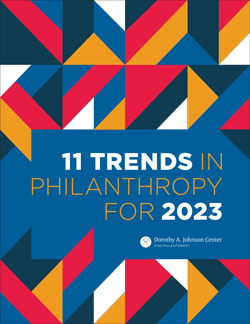Will Philanthropy Stay Focused on Racial Equity?


 This article was first published in our 11 Trends in Philanthropy for 2023 report. Explore all 11 trends in the report.
This article was first published in our 11 Trends in Philanthropy for 2023 report. Explore all 11 trends in the report.
Want the latest trends, research, and more delivered right to your inbox? Subscribe to the Johnson Center email newsletter.
One of the oft-mentioned benefits of philanthropy as practiced in the U.S. is the ability of private donors and foundations to be responsive to changing needs. Indeed, philanthropy can move quickly in response to natural disasters, for instance, or in the case of local emergencies like building fires or infrastructure failures. We saw countless foundations and individual donors and families leap into action as waves of coronavirus rocked the globe (for greater details, see Candid’s Philanthropic Response to Coronavirus (COVID-19) dashboard, n.d.).
One of the downsides of this flexibility, however, is the opportunity for faddism in philanthropy. In Philanthro-Fads: Trends in Philanthropy That Do—and Don’t—Work, Suzanne Skees (2014) identified philanthropy trends she saw from her position in a family foundation: prize philanthropy, micro-finance, funding women and girls, social entrepreneurism, and cash transfers each had their moments in the philanthropy spotlight.
“[R]esearch shows that funding for racial equity has risen dramatically over the past two years especially, although a few major donors such as MacKenzie Scott and the Ford Foundation may be skewing the data.”
A review of the conference themes for one of the largest state associations of grantmakers reflects these changes in attention. One can look over the list of keynote speakers and identify which book was published that year, with the author making the speaking circuit.
As one example, when Edgar Villanueva’s book Decolonizing Wealth was published in 2018, land acknowledgments became common, and Villanueva was a popular conference speaker. But how many donors and foundations actually shifted their giving to support Native Americans? According to research by the Center for Effective Philanthropy, very few. Even at the height of the pandemic, when Native communities were suffering disproportionately, two-thirds of nonprofits serving these communities received no additional support (Buteau et al., 2021).
As another example: Anand Giridharadas was a popular speaker after his 2018 critique of philanthropy, Winners Take All: The Elite Charade of Changing the World, was published. However, we have yet to see significant changes in payout rates or in regulations that address the concentration of wealth and the influence of megadonors.
That said, the evidence does show that fads in giving have their place — and their impact. Five years after the viral Ice Bucket Challenge “soaked the world” with $115 million in support for the ALS Association (2019), independent evaluators concluded that the one-time influx of cash had been transformative for the field. The ALS Association used that money to increase annual research funding by 187% by 2019, expanded its clinical network by 50%, and discovered five new genes related to the disease, among other major accomplishments. Interest from donors may have been short-lived, but their impact will be felt well into the future.
Philanthropy’s response to today’s racial justice reckoning raises the question of when foundations and donors are being truly responsive, reflecting on and changing current practices and priorities, and when they are simply jumping on a trend that might not last. The number of conference sessions, public statements, and research on racial justice has skyrocketed in recent years. But how much of this represents real change and responsiveness to entrenched and emerging needs, versus wanting to be seen as responsive and connected to community — to be part of a trend?
At the Johnson Center, we have been struggling for several years now with how we should cover philanthropy’s changing relationship to racial equity as a giving/funding priority within our annual 11 Trends in Philanthropy reports. There is, unquestionably, a large amount of activity going on here. The question is whether that activity — the numerous pledges, equity statements, and realignments — represents a true trend in our sector, or rather a moment in time.
There is room for hope. There are examples of foundations and collaboratives that have made commitments to racial equity and are following through with actions. Data support reasons for optimism:
At its 2019 annual conference, the Council of Michigan Foundations (CMF) invited its members to join a collective and ongoing equity journey that remained a focus of conferences in 2020, 2021, and 2022. CMF has committed (n.d.), with the launch of its strategic framework in 2020, to center its work in equity, with racial equity specifically imperative.
Three Chicago-based organizations (Chicago Beyond, Grand Victoria Foundation, and the John D. and Catherine T. MacArthur Foundation) launched the Abundance movement in April 2022. In their press release, they describe it as “a movement dedicated to shifting how philanthropic dollars are allocated to Black-led and Black-centered organizations. Philanthropic organizations that join the Abundance movement will commit to significantly raising their annual payout to Black-led work by the start of 2025, with growth year after year” (MacArthur Foundation, 2022, para. 2)
The 2021 Philanthropic Initiative for Racial Equity report found that while funding for racial equity and racial justice was a small portion of foundation funding, it “grew steadily from 2011 through 2018. During that time period, funding for racial equity more than doubled from $2.12 billion in 2011 to $5.15 billion in 2018. Funding for racial justice nearly tripled, from $331 million in 2011 to $926 million in 2018” (Cyril et al, para. 9).
Is the focus on racial equity a trend? We saw a similar emphasis on racial justice after Hurricane Katrina laid bare the inequities in health care and housing that led to disaster for Black people in Louisiana. That interest faded as new stories grabbed the headlines and philanthropy moved on to other topics.
However, it appears there has been movement toward greater funding of racial equity and a continuing focus on it. We are less than three years out, so it may be too soon to call, but the available evidence supports the idea that this is a shift in the sector that may endure. If not, it will become part of the trend of philanthropy following trends.
Abundance. (n.d.) What would it look like if philanthropy celebrated Black Abundance instead? https://www.abundancemovement.org
ALS Association (2019, June 4). Ice Bucket Challenge dramatically accelerated the fight against ALS. https://www.als.org/stories-news/ice-bucket-challenge-dramatically-accelerated-fight-against-als
Buteau, E., Martin, H. and Malmgren, K. (2021) Overlooked (Part 2): Foundation support for Native American leaders and communities. Center for Effective Philanthropy. http://cep.org/wp-content/uploads/2021/07/CEP_Overlooked_Native_American.pdf
Candid. (n.d.). Philanthropic response to coronavirus (COVID-19). https://candid.org/explore-issues/coronavirus
Candid. (2022, January 5). Funding for racial equity. https://candid.org/explore-issues/racial-equity
Council of Michigan Foundations. (n.d.). Equity at the center. https://www.michiganfoundations.org/equity/our-strategic-framework
Cyril, M. D., Kan, L. M., Maulbeck, B. F., & Villarosa, L. (2021). Mismatched: Philanthropy’s response to the call for racial justice. Philanthropic Racial Equity. https://racialequity.org/mismatched/
Giridharadas, A. (2018, August 28). Winners take all: The elite charade of changing the world. Alfred A. Knopf.
Giving USA. (2022). Giving USA 2022: The annual report on philanthropy for the year 2021. Giving USA Foundation.
Hadero, H. (2021, September 17). MacKenzie Scott dominates donations to racial equity. AP News. https://apnews.com/article/death-of-george-floyd-health-education-coronavirus-pandemic-race-and-ethnicity-42ca645d713108d5c852ee3d024b6361
MacArthur Foundation. (2022, April 18). Movement to end philanthropy’s complicity in anti-Blackness [Press release]. https://www.macfound.org/press/press-releases/movement-to-end-philanthropy’s-complicity-in-anti-blackness
Skees, S. (2014, May 24). Philanthro-fads: Trends in philanthropy that do—and don’t—work. Skees Family Foundation. https://www.skees.org/story/philanthro-fads-trends-in-philanthropy-that-do-and-dont-work/
Villanueva, E. (2018, October 16). Decolonizing wealth: Indigenous wisdom to heal divides and restore balance. Berrett-Koehler Publishers.